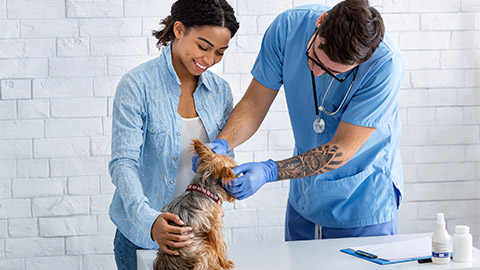In the workplace there are many options available to you for sourcing information, it is vital that these sources are reliable.
When conducting research ask yourself the following questions:
-
"Is the information which I am reading current?" - Look for a date for when the article/book/website was published or last updated.
-
"Who is the author and what are their credentials?" - Authors who are linked to or recommended by an accredited industry association are more likely to be reliable than random internet site bloggers. Also, information that is 'peer-reviewed' and published in an accredited journal has been deemed by industry peers to be legitimate.
There are also other less formal sources of information that you may be required to research or conduct an enquiry with.
The animal's owner is often your first source of information. They know their pet's behaviour, temperament, history and symptoms better than anyone.

The first step in an animal health assessment is obtaining an accurate and precise history. If you are working in the veterinary sector, you may be required to perform preliminary health checks on your patients at the time of routine health care (such as vaccinations) or potentially when they present to the clinic sick or injured. Animal health assessments should always include taking a patient history.
Patient history records should contain the following information:
- Patient identification including name, species, breed, age, sex and owner details.
- Previous medical history.
- Current vaccination status.
- Preventative treatments in use.
- Diet and appetite.
- Other animals in the household.
- Symptoms of illness or injury.
- Behavioural concerns.
It is best to develop a systematic approach to taking a history. If you always take histories in the same way you are less likely to overlook important details and more likely to pick up on abnormalities. Your workplace may have an official document or database system where this information is recorded.
Ensure that any information that you retain in either written or electronic form, especially confidential information like contact or financial details, are securely maintained in either locked filing cabinets or a password-protected database.
When discussing the information with the owner, utilise active listening processes to demonstrate that they have your full attention, you are interested in what they are saying and that you are following the conversation. In turn, this encourages them to keep talking.
Effective active listening techniques are outlined below:
- Body language - Nodding your head, Smiling, Facing the other person, Eye contact.
- Asking questions for information and clarification - Helps to clarify facts and gain more information, shows the speaker that you are interested.
- Paraphrasing - Stating in your own words what you think someone has just said, lets the speaker know you have understood the message. For example “What I hear you’re saying is ...” OR “In other words ...” OR "So what happened was..."
You can review/download copies of legislation and regulations from State Government websites.
Click on the icon in your relevant state/territory on the image below, in the pop-up box refer to the website link to view/download a copy of your local Animal Welfare / Prevention of Cruelty, Workplace Health and Safety, or Environmental Protection legislation.
Most local governments (councils) require domestic animals such as cats and dogs to be registered and they maintain these registers. You may not be authorised to access these records as part of your job, however, the council's website will provide general information about animal registration and regulation that may be useful.
Industry associations provide consistent and reliable information and assistance to workplaces and personnel in the animal care industry. They are often membership based and they use the money they raise in membership to further their research, education services and government liaison as a means of benefiting members through a united voice.
Industry associations may produce Codes of Practice which provide benchmark standards to individual workplaces on topics relevant to the association and specific types of animal/s they are involved with. Codes of Practice may cover welfare information related to feeding, health, hygiene, housing, safety/hazards and environmental considerations.
Some examples of industry associations are:
- Australian Veterinary Association
- Pet Industry Association of Australia
- Animal Medicines Australia
- Meat & Livestock Australia
- Guide Dogs Australia
Breed clubs provide information about specific breeds of animals, for example, Labrador dogs or Burmese cats. They can be helpful if you are researching common ailments that afflict certain breeds or just for obtaining general information about the behavioural characteristics of that type of animal. This type of information may be required if you are working in a pet store and a potential customer wants information about the suitability of the animal for their family or lifestyle.
A microchip is a permanent method of electronic identification. The chip itself is very small – about the size of a grain of rice – and is implanted just under the skin, between the shoulder blades at the back of the animal's neck. Each chip has a unique number that is detected using a microchip scanner. The microchip number is recorded on a database registry with details about the animal and owner.
There are various private microchip registering companies and also some state government-funded databases (South Australian and New South Wales) in Australia. State / Territory Governments are responsible for administering/regulating the registration licences of these companies. Veterinary clinics and local councils can access owners information from the relevant registering company when they encountered a lost or stray animal.
Some examples of these companies are:
- HomeSafeID (Private company)
- South Australian Government Registry - Dogs and Cats Online (Government-run database)
- Greyhound Racing Victoria (Government database specific for Greyhounds)
The manufacturer's information contained on over the counter product packaging and insert leaflets is usually a reliable source of information. Often these products will be tested by and recommended by industry associations, other products are subject to legislative and regulatory approval processes prior to being made available for use.
Your workplace supervisor will probably be making the initial decision to stock a certain product and they will have conducted the necessary research to determine its suitability.
Product packaging and inserts contain information on treatment purposes, recommended dosages, application procedures, ingredients, side effects. You can also obtain information about products directly from the manufacturer's website.
For Dogs over 25 kg
100 g/L Imidacloprid
25 g/L Moxidectin
Tubes are not for individual sale
For:
- the treatment and prevention of fleas Ctenocephalides spp. Reduces the incidence of Flea Allergy Dermatitis. Larval flea stages are killes in the surroundings of ADVOCATE treated pets;
- the prevention of heartworm Dirofilaria immitis infection;
For the treatment and control of:
- roundworms Toxocara canis, Toxascaris leonina, kills larval (L1), immature and adult worms;
- hookworms Ancylostoma caninum, Ancylostoma braziliense (this hookworm is usually restricted to tropical areas in Australia), Ancylostoma ceylanicum, Uncinaria stenocephala, kills larval (L1), immature and adult worms of all species.;
- whipworm Trichuris vulpis;
- generalised demodicosis Demodex canis;
- sarcoptic mange Sarcoptes scabiei;
- ear mites Otodectes cynotis;
- lice Trichodectes canis, Linognathus setosus for up to 6 weeks;
in dogs and puppies.
One application lasts for a month.
Directions for use
Consult a veterinarian before use.
Treatment for heartworm should occur regularly at monthly intervals. For external application only.
Do not give product by mouth.
Dosage
| For animals of this type | Use 1 TUBE from this pack colour | |
|---|---|---|
| Dogs | 10—25 kg | maroon |
| Dogs | 25—50 kg | blue |
For very large dogs over 50 kg, apply 2 tubes of ADVOCATE for Dogs over 25 kg (blue) by dividing the dose between the shoulder blades, on the middle of the back between the hips, and at one point in between.
When medications are prescribed by a veterinary practice, they must have a label attached to them, outlining the following items:
- Veterinarian dispensing the medication.
- Date.
- Veterinary clinic name, address and phone number.
- Safety disclaimers "Keep out of reach of children" and "For Animal Treatment Only" in red.
- Client name.
- Patient name, age, species, sex and breed.
- Drug name, strength, amount and expiration date.
- Instructions for giving the medication and dose rate.
For animal treatment only
Keep out of reach of children
TAFESA Pets inTuition Veterinary Clinic
Blacks Road
Gilles Plains, SA 5086
8207 1177
| 11/11/2009 | Ian Hough | |
|---|---|---|
| 1211 Rx#: 456 |
Ian Hough Canine |
Cheeky Border Collie |
| Directions: Give one (1) tablet by mouth twelve hourly for five (5) days. | ||
| Expires: 30/04/2010 Quantity: 10 |
Refills: 0 Noroclav Tabs 250 mg |
|
Documents that provide critical information about hazardous chemicals are known as Safety Data Sheets (SDS), they may also be referred to their previous name of Material Safety Data Sheets (MSDS). These documents include:
- Chemical's name.
- Manufacturer/supplier's name and contact information.
- Chemical's ingredients.
- Health and physical hazards.
- Safe handling and storage procedures.
- Emergency procedures.
- Disposal considerations.
In Australia, manufacturers and importers of hazardous chemicals must prepare a SDS for each product and make this readily available. Workplaces must keep copies of relevant SDS's in a readily accessible location for all employees who may require them. Your workplace will potentially have these in a manual or computer system. Note: SDS's are regularly updated and it is important that workplaces check for any updates on a routine basis and download/print out the correct version for their manual.

You may also be able to source information from the following places:
- Libraries - Textbooks, newspapers, medical journals - just make sure the information is up to date.
- Validated internet sites - Look for author credentials or affiliations, domain names ending in .gov or .edu, professional layout (no spelling or grammar errors), references/citations.
- Supervisor / Colleagues - Experienced and educated members of the industry a great source of information.
Record keeping is a form of written communication, specifically the maintenance of information that is likely to be referred to at a later date.
In an animal care environment, you may be responsible for maintaining workplace records such as client records, treatment and medication notes/logs, animal identification records, dietary information, training/socialisation/exercise details, stock control, financial records and hygiene processes, just to name a few.
The following guidelines for record-keeping should always be observed:
- Handwrite legibly if using paper-based documents and complete accurate data entry when using computers.
- Include your name and signature where applicable.
- Make sure you date, and if necessary, timestamp the record.
- Be mindful of your language, remember the records may be shown to members of the public someday, avoid abbreviations if you can and never write any insulting comments.
- Focus on facts, not speculation.
- Do not erase information that has previously been recorded, if an amendment is required simply cross out the older entry with a single line (so that it can still be read by others if need be) and write the new information next to it. Initial and potentially date the change.
- Respect privacy if personal details are provided, inform people if you need to share details with any third parties.
- Save / store records in a secure location such as a database with login/password requirements or a locked filing cabinet.

